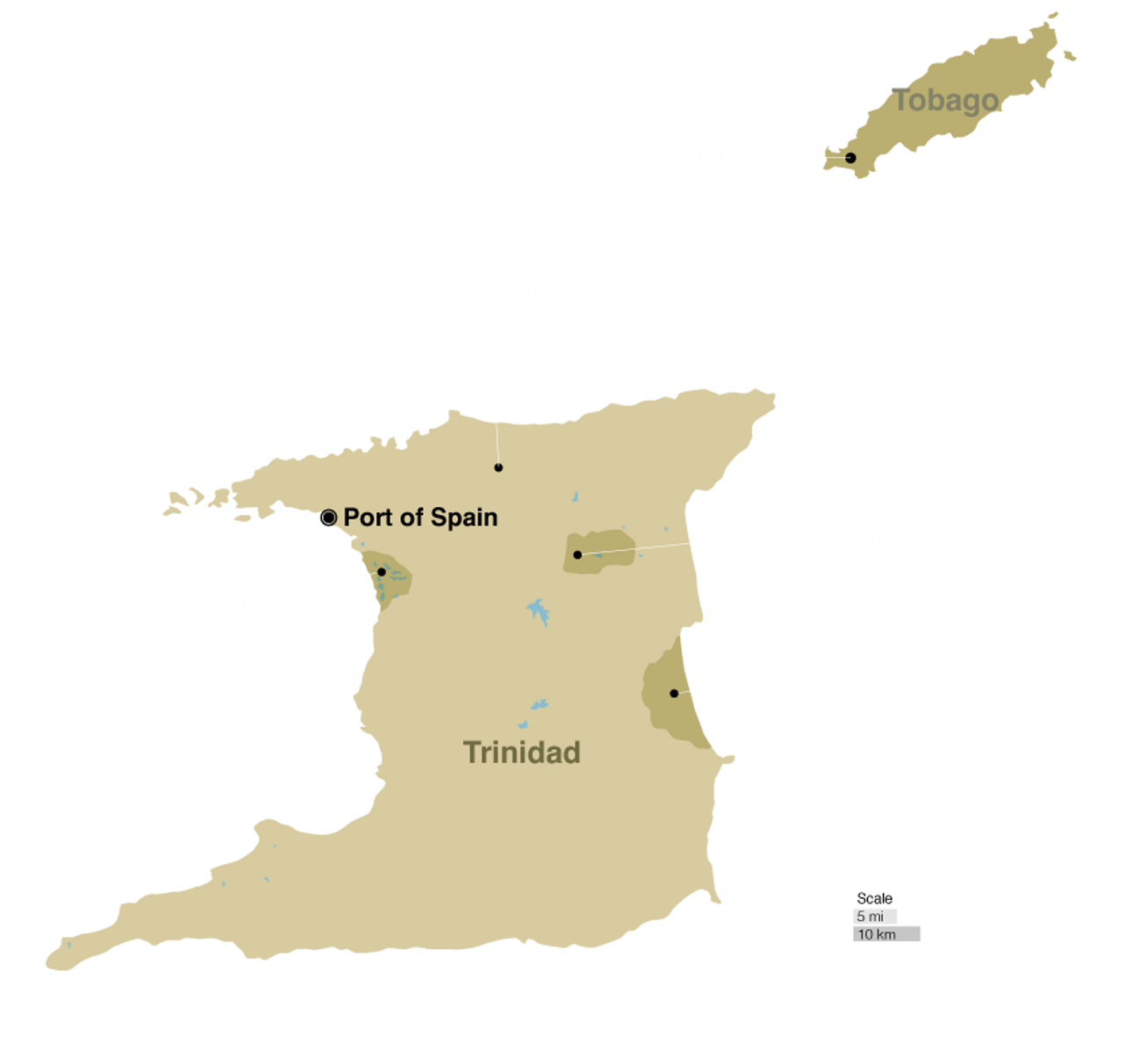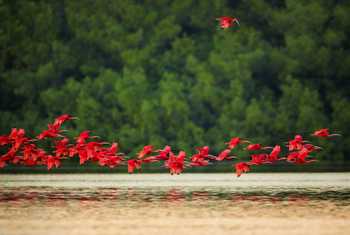


Location Highlights
- Asa Wright Nature Reserve - 'doorstep' birding at one of the finest wildlife lodges in the Caribbean
- Nariva Swamp - Trinidad's largest and most diverse wetland complex
- Caroni Bird Sanctuary - an important mangrove reserve famous for its roosting Scarlet Ibis
- Blanchisseuse Road - an excellent birding road winding through the Northern Range
- Tobago - stunning beaches and a laidback atmosphere


Tailormade Holidays in Trinidad & Tobago
Tailormade | Tour Code: TTRICreate your own Tailormade holiday to Trinidad and Tobago with dates and an itinerary to suit you.
When to Visit
| J | F | M | A | M | J | J | A | S | O | N | D |
| YY | YY | YY | YY | YY | Y | Y | Y | Y | Y | Y | Y |
SAMPLE HOLIDAY: Classic Trinidad & Tobago
13 days from £6,995 (Flight Inclusive)
Location Highlights
- Asa Wright Nature Reserve - 'doorstep' birding at one of the finest wildlife lodges in the Caribbean
- Nariva Swamp - Trinidad's largest and most diverse wetland complex
- Caroni Bird Sanctuary - an important mangrove reserve famous for its roosting Scarlet Ibis
- Blanchisseuse Road - an excellent birding road winding through the Northern Range
- Tobago - stunning beaches and a laidback atmosphere


Quick Enquiry
Summary
Trinidad and Tobago both experience a tropical climate with warm temperatures year-round, and, with many of the seemingly complex range of South American bird families represented, offer a superb destination for a combination of wildlife and relaxation. Forested hillsides and dense mangroves also provide habitat for a good range of mammals and reptiles, with species including Red-rumped Agouti, the striking Gold Tegu, and the critically endangered Trinidad White-fronted Capuchin. The Asa Wright Nature Centre, in the scenic northern range, is an ideal base from which to explore nearby sites, providing standards of comfort and viewing facilities that similar establishments elsewhere in South America can only aspire to equal. Along the coastlines exist important nesting sites for Leatherback, Hawksbill and Green Turtles, while mangrove channels offer refuge for West Indian Manatees. The small island of Tobago boasts pristine coral reefs, breathtaking beaches, and its own unique biota, including species not found on neighbouring Trinidad, such as Blue-backed Manakin and the endemic Tobago Coral Snake. The vibrant culture, fresh food, and the relative ease with which the islands’ tropical wildlife can be observed, combine to make Trinidad and Tobago a real Caribbean treasure.
Our Destinations

Situated on Trinidad's eastern flank, Nariva Swamp is the island's largest wetland complex and an internationally designated Ramsar site. It serves as important habitat for rare species including Red-bellied Macaw, Epaulet Oriole and Rufescent Tiger-heron, in addition to an abundance of egrets, crakes, bitterns and rails. The waterways also support West Indian Manatee, while the riverine forests host populations of Guyanese Red Howler and the endemic Trinidad White-fronted Capuchin Monkey, of which fewer than 50 mature individuals remain. Other notable resident birds include Silvered Antbird, Bicoloured Conebill, Black-crested Antshrike, Red-rumped Woodpecker and White-tailed Goldenthroat.

On the west coast of Trinidad, a network of forest-cloaked freshwater channels spill into the Gulf of Paria, creating a unique brackish water habitat that supports a diverse range of life. Along the muddy margins, a wealth of waders find their home, while kingfishers dart across the channels and raptors soar overhead. Caroni’s dense mangrove forest also hosts a marvellous array of herons and egrets, while chancing upon a sleeping Silky Anteater or a spectacular Ruschenberger’s Tree Boa is always a possibility. However, the star of the show is no doubt the afternoon arrival of hundreds of Scarlet Ibis, which, with the downing of the sun, gradually transform their mangrove-island roost into a fluorescent pink mass.

Asa Wright Nature Reserve sits amid the rich forested north of Trinidad. A network of well-marked trails wind through pristine forest, whose inhabitants include Palm, Silver-beaked and Blue-Grey Tanager, Crested Oropendola, Great Kiskadee, Orange-winged Parrot, Channel-billed Toucan, Bearded Bellbird, Scaled Pigeon, Black-tailed Tityra, Swallow-tailed Kite and more. Mammals to look out for include Red-rumped Agouti and Trinidad Squirrel, while the impressive Gold Tegu is commonly encountered. A visit here also provides a fantastic opportunity to observe an Oilbird colony from the mouth of their cave.

The Blanchisseuse Road winds through forest cloaking the higher elevations of the Northern Range, above the Asa Wright Centre. All three species of Trogon are likely and on occasions these impressive forest dwellers can offer remarkable viewing opportunities. If fruiting trees are in proximity, Channel-billed Toucans may be tempted near the road, as indeed might be other fruit-loving species such as Scaled Pigeon and Blue-headed Parrot. A variety of small birds inhabit the forest undergrowth and species to look for include Black-faced Ant-thrush, White-bellied Antbird, Rufous-breasted Wren, Stripe-breasted Spinetail, Red-crowned Ant Tanager and Plain Antvireo. It is always prudent to keep an eye on the birds soaring over the forests and whilst many will be Black or Turkey Vultures, Common Black Hawk, White Hawk, Short-tailed Hawk and Ornate Hawk Eagle are all likely to also take advantage of the thermals.

Tobago lies just 30 kilometres northeast of Trinidad, across the Caribbean Sea. Despite its proximity and legislative ties to its larger neighbour, Tobago boasts a distinct character and its own unique suite of birds. The Tobago Rainforest Reserve, running down the spine of the island, offers the chance to see species absent from Trinidad, such as Blue-backed Manakin, White-tailed Sabrewing, and Yellow-legged Thrush. Seabirds adorn the skies, and an excursion to Little Tobago Island may provide stunningly close views of Red-billed Tropicbirds, boobies, and Magnificent Frigates. Meanwhile, the beautiful white-sand beaches and glistening coral reefs, combined with a famously laidback atmosphere, provide a relaxing finish to a wildlife holiday.

This exceptional location is set up in the gardens of a private residence and accessible by appointment only, promising a truly intimate and unique experience. It is not unusual to see up to 14 different species of hummer in a single visit, and the opportunities for photography are second to none. Frequent visitors to the feeders include Copper-rumped and Ruby Topaz Hummingbirds; Blue-chinned Sapphire; White-chested Emerald; White-necked Jacobin; Green, Little and Rufous-breasted Hermit; Rufous-shafted Woodstar and Tufted Coquette. The owner also showcases a stunning photographic gallery, and some of his remarkable artwork is available to purchase on request.

Just to the south of Caroni Swamp lie the mudflats of Waterloo and Brickfields. This is an excellent location for pelagics and shorebirds alike, with large numbers of Yellow-billed and Large-billed Terns, as well as Collared Plovers that breed between April and October. Many of Trinidad’s shorebirds are passage migrants, but residents include Wilson’s Plover; Spotted, Solitary, Pectoral, White-rumped and Stilt Sandpipers; American Golden Plover and Hudsonian Godwit. The Gulf of Paria’s shallow waters provide sheltered habitat for such rarities as Maguari Stork, Derek Sandpiper and Rufous Crab-Hawk, while other highlights might include Magnificent Frigatebird, Brown Pelican and a diverse collection of herons. The beautiful Hindu ‘Temple in the Sea’ is also worth a visit.

The Tamana caves are hidden away in Trinidad’s eastern interior, on the northern slope of Mount Tamana. Accessible only on foot, the walk through old plantations and dense forest can be tough going, but typically lasts about an hour. Upon arrival at the cave’s entrance, the trail descends some 20 metres into the first chamber, where thousands of bats make their home. For the brave, squeezing through an access hole permits entry into a second chamber. This is adventure not for the faint hearted, though, and the cave’s floor is carpeted in guano and insects. However, the spectacle of innumerable bats darting past at breathing distance, orchestrated with surgical-like precision so as never to make contact, is an experience like no other. 11 species of bat roost permanently here, including Geoffroy's Tailless, Greater spear-nosed and Trinidadian Funnel-eared Bat.

The expansive tropical savannah ecosystem of Aripo stands as one of the few remaining of its kind in the Caribbean. Located at base of the Northern Range, Aripo is characterised by its open grassland, scattered trees, and wetland areas, offering a distinct habitat to the moist forests of the hills. The savannah is home to a range of dry and open-country specialists, including Savannah Hawk, Pearl, Grey-lined and Plumbeous Kite, Yellow-headed Caracara, Southern Lapwing, Green-rumped Parrotlet, Striped Cuckoo, Black-crested Antshrike, Yellow-bellied Elaenia, Golden-fronted Greenlet, Rufous-browed Peppershrike, Masked Yellowthroat and more. Swathes of Moriche Palm also provide an important food source for several macaw species.

Nestled on the northern coast of Trinidad, the gorgeous beaches of Grande Riviere play host to one of the most significant nesting grounds for Leatherback Turtles worldwide. These marvellous creatures come ashore in their droves between March and August to lay their eggs. An adult Leatherback can weigh as much as 700 kilograms, making them the largest of marine testudines. Another star attraction here is the opportunity to encounter an endemic Trinidad Piping Guan. Known locally as ‘Pawi’, this segment of the island offers the most reliable chances for this iconic and otherwise elusive bird. Other birds might include Grey-headed, Plumbeous and Swallow-tailed Kites, Lesser Swallow-tailed Swift, Channel-billed Toucan and Crimson-crested Woodpecker.
Sample Itineraries

What's Included?
- Accommodation:
- Food:
The Essentials
- Wildlife Guides: Quality in-house naturalist guides are available at our suggested lodges. However, should you prefer to have a dedicated naturalist accompany you throughout your holiday, this can be easily arranged.
- When to Visit: Trinidad and Tobago experience a tropical maritime climate, with a dry season running from January to May, followed by a wet season characterised by higher temperatures, humidity, and rainfall. Temperatures typically range from 20 to 30°C with hilly areas dropping below 20°C at night. On the Atlantic coasts the trade winds bring relief and Tobago is generally less humid than Trinidad. Many of the usual target species are resident all year round, while huge Leatherback Turtles come ashore to breed in Tobago between March and August.
J F M A M J J A S O N D YY YY YY YY YY Y Y Y Y Y Y Y - Getting Around: Generally, the roads are good and most car journeys are no longer than an hour or two. Many wildlife sites can be accessed while staying at a ‘single centre’, either on foot, by road or by boat. Several daily flights connect Trinidad and Tobago and take around 20 minutes. A ferry ride of around two and a half hours is also an option.
Why Naturetrek Tailormade?
'A Naturetrek Tailormade holiday allows you, with the benefit of our wildlife travel expertise and destination experience, to enjoy the perfect private wildlife holiday – one that truly matches your requirements, expectations and ambitions. We will ensure the most competitive prices, superb naturalist guides and seamless ground services.
Some of the benefits of Naturetrek Tailormade travel include:
• A bespoke itinerary which is crafted by experts and designed specifically for you
• Private guiding by the very best local naturalists
• Travel with people you know, at your own pace
• Incorporate as much culture, history or relaxation time as you wish
• Choose dates to suit you
• Select your preferred style of accommodation
• Travel with families and children of any age
Furthermore, our Tailormade team are always on hand to help and guide you along the way, with friendly advice, first-hand knowledge and inside information specific to your destination of choice. So if you have any queries about your holiday, we will be delighted to answer them. Please just give us a call!'




 Loading search...
Loading search...






























